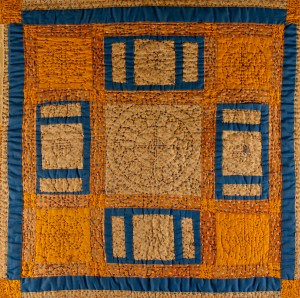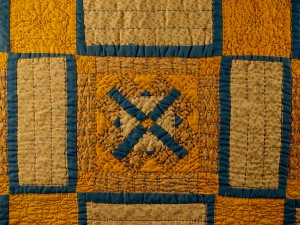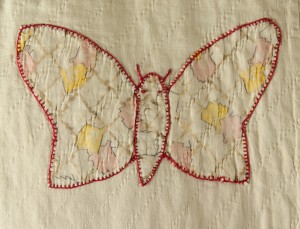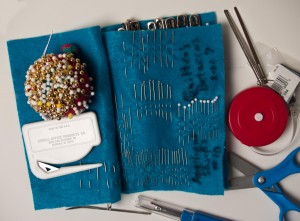 My artist’s bug-out bag was not foremost on my mind while getting ready for Hurricane Sandy. I was busy prepping as much as I could to brace the house against the on-coming onslaughts of the forecast winds. Those tasks took up most of my time, but I did at least locate my small artist’s gear bag to grab in case I needed to evacuate.
My artist’s bug-out bag was not foremost on my mind while getting ready for Hurricane Sandy. I was busy prepping as much as I could to brace the house against the on-coming onslaughts of the forecast winds. Those tasks took up most of my time, but I did at least locate my small artist’s gear bag to grab in case I needed to evacuate.
The term, bug-out bag apparently comes from the Korean War, where it was a bag of necessities to grab in case your camp was about to be overrun. In a previous blog, I wrote about how I had put together a similar kit of art quilting supplies in case I needed to evacuate. The Peace Gardens that I had in the bag to make I envisioned giving me comfort while I was away from home. However, as Sandy approached, I only had time to make sure that the artist’s bag was with the bigger one that had some clothes and other necessities. However, after some of the debris outside was cleaned up here in Maryland, I decided to open the bag, and see if I still liked what I saw. Am I ever glad that I did, as there are some changes that need to be made.
In the above photo are some of the tools that I included in my bag. The first thing that I noticed was how pathetic the scissors were. I had put the bag together after the airline rules had come into play regarding the length of scissors that you could carry on a plane, but these are paper scissors. I did have an envelope opener, with its short razor blade in the finger of the curve that could be taken on a plane before short scissors were allowed back on, but paper scissors? You can’t cut threads neatly with those. I left them in my bag to pass on to a small child in my imagined future evacuation center, but added some better ones to my bag. The rest of the above supplies of lots of assorted needles and bodkins, seam ripper, tape measure, and pin cushion all were acceptable.
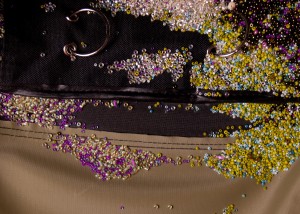 Another reason that I was glad that I had re-opened my bug-out bag was the number of plastic bead bags that had burst over time being squashed against each other. This photo shows the hundreds of seed beads that were loose in the bottom of the main bag. Over time, I’ve had a few bead disasters that have resulted in spilled beads. You have no idea how well this little pieces of glass can bounce down an aisle on an airplane, so I’ve learned how to only take a few out at a time of one color and work just with them to minimize bead loss (and embarrassment.) I can only imagine what would have happened if I had opened my bag in an evacuation center, since from what I’ve seen on TV, you only get the space of a cot to call yours.
Another reason that I was glad that I had re-opened my bug-out bag was the number of plastic bead bags that had burst over time being squashed against each other. This photo shows the hundreds of seed beads that were loose in the bottom of the main bag. Over time, I’ve had a few bead disasters that have resulted in spilled beads. You have no idea how well this little pieces of glass can bounce down an aisle on an airplane, so I’ve learned how to only take a few out at a time of one color and work just with them to minimize bead loss (and embarrassment.) I can only imagine what would have happened if I had opened my bag in an evacuation center, since from what I’ve seen on TV, you only get the space of a cot to call yours.
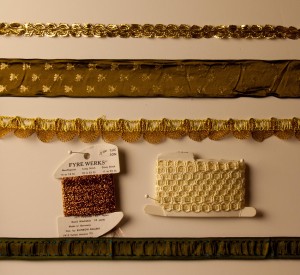 What would an art quilt be without ribbons, trims, and the all important binding? The widest piece shown here is a 2″ or 2.5 cm wide olive green, satin ribbon with bees on it. I bought a large spool a number of years ago, and have used it for all of the Peace Gardens banners. Since room is limited in my small bag, I only put snippets of what I have from my extensive collection in my studio. I only hope that if I did have to evacuate at some point, I would be grateful for what I did have with me and not bemoan what I had had to leave behind in the huge boxes in my studio.
What would an art quilt be without ribbons, trims, and the all important binding? The widest piece shown here is a 2″ or 2.5 cm wide olive green, satin ribbon with bees on it. I bought a large spool a number of years ago, and have used it for all of the Peace Gardens banners. Since room is limited in my small bag, I only put snippets of what I have from my extensive collection in my studio. I only hope that if I did have to evacuate at some point, I would be grateful for what I did have with me and not bemoan what I had had to leave behind in the huge boxes in my studio.
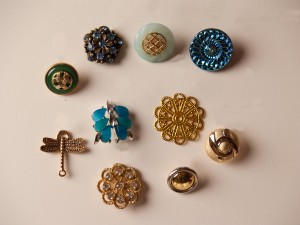 Since I bill myself as “The Self-Proclaimed Button and Bead Queen of Maryland” on my web site, of course, I have buttons and snippets of jewelry in my bug-out bag. These are just some samples of the different color combinations that I have, as I wanted ones that would work in the idyllic garden theme that I’ve used in my other Peace Gardens banners. Again, choices had to be made, as I have boxes and boxes of possibilities in my studio, but size of the buttons was an important consideration, as the banners are small.
Since I bill myself as “The Self-Proclaimed Button and Bead Queen of Maryland” on my web site, of course, I have buttons and snippets of jewelry in my bug-out bag. These are just some samples of the different color combinations that I have, as I wanted ones that would work in the idyllic garden theme that I’ve used in my other Peace Gardens banners. Again, choices had to be made, as I have boxes and boxes of possibilities in my studio, but size of the buttons was an important consideration, as the banners are small.
Besides the burst bead bags, the biggest surprise upon opening the bag after probably 3-4 years since I first put it together is that I only have one small art quilt in there. I had taken out three of the others and finished them to hang at some retreats that I’ve been on, and forgotten that I had not replaced them. I would have really been disappointed to have gotten to a shelter, only to find that I had a square foot of a quilt sandwich to work on, and it’s almost finished! More quilt sandwiches need to go in that bag!
My small canvas bag is actually a bait and tackle bag from a fishing shop. Measuring about 12″W x 8.5″T and 9″D when stuffed ( 30.5cm W x 21.5cmT and 23″D), there are a lot of art supplies in the 10 pounds (4.5kg) that it contains. I view it as my “teddy bear” that I would take me with me, and I could sit and sew and sew and sew to distract me from my surroundings and plight. I am so very, very grateful that I didn’t need to evacuate this time, but I am comforted that I have my bag ready….as soon as I put some more quilt sandwiches in it!
What art supplies would you put in your own version of a bug-out bag? How would you go about choosing what would go in it?
Why not leave a comment as to your thoughts on this posting. Please take a minute, fill out the form below or by clicking on the “comments/no comments link” at the top of the posting, and then share your ideas with the rest of us. We all grow when we share our thoughts and impressions, so why not join our growing community of those who appreciate art quilts and textile arts. We’d love to hear from you!
You can see more of my art work on my web site at www.fiberfantasies.com (be patient as it loads; it’s worth it), my healing work at www.hearthealing.net and can find me on Google + , Facebook (for Transition Portals) Facebook (for Fiber Fantasies), and Twitter.
To find out how to buy my art work, please check out “How to Buy my Art Work” in the “Pages” section to the right of this blog.

